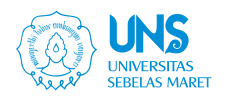Development of Roselle (Hibiscus sabdariffa L.) Calyx Jelly Candy
| Dublin Core | PKP Metadata Items | Metadata for this Document | |
| 1. | Title | Title of document | Development of Roselle (Hibiscus sabdariffa L.) Calyx Jelly Candy |
| 2. | Creator | Author's name, affiliation, country | Yuniwaty Halim; Department of Food Technology, Faculty of Science and Technology, Universitas Pelita Harapan, Tangerang; Indonesia |
| 2. | Creator | Author's name, affiliation, country | Cindy Evelyne; Department of Food Technology, Faculty of Science and Technology, Universitas Pelita Harapan, Tangerang; Indonesia |
| 2. | Creator | Author's name, affiliation, country | Dela Rosa; Department of Pharmacy, Faculty of Health Sciences, Universitas Pelita Harapan, Tangerang; Indonesia |
| 2. | Creator | Author's name, affiliation, country | Salfarina Ramli; Faculty of Pharmacy, Universiti Teknologi MARA Cawangan Selangor, Selangor, Malaysia; Integrative Pharmacogenomics Institute (iPROMISE), Universiti Teknologi MARA Cawangan Selangor, Selangor; Malaysia |
| 3. | Subject | Discipline(s) | food technology; food processing |
| 3. | Subject | Keyword(s) | anthocyanin; antioxidant; color; physicochemical properties; roselle calyx |
| 4. | Description | Abstract | Jelly candy is syrup-phase, non-crystalline candy made using sugar, corn syrup and gelling agents such as gelatin, natural gums, pectin or starch. Roselle (Hibiscus sabdariffa L.) has red edible calyx that is the potential to be used as a natural colorant for jelly candy as it contains anthocyanins. The objective of this research was to determine the effect of different concentrations of dried roselle calyx and sucrose on the characteristics of roselle calyx jelly candy developed. The concentrations of sucrose used were 63.56%, 70.62%, 77.68% and 84.75%. The concentrations of dried roselle calyx used were 6.67%, 10.00%, 13.33% and 16.67%. Sensory analysis was done with 70 untrained panelists to analyze physical characteristics and preferences toward the jelly candies. Results of hedonic tests indicated that the best-formulated jelly candy according to aroma, texture, color and taste was made using 16.67% of dried roselle calyx and 63.56% of sucrose. The best-formulated jelly candy contains 19.52% of moisture, 0.03% of ash, 8.24% of protein, 1.72% of fat and 70.49% of carbohydrates. The selected jelly candy contains 14.23±0.23 mg 100g-1 of anthocyanin and an antioxidant capacity (IC50)value of 16863.8346 μg ml-1. This research shows the potential use of roselle calyx as a natural colorant in jelly candy manufacturing and can be consumed as a healthier option for sweet treats. |
| 5. | Publisher | Organizing agency, location | Universitas Sebelas Maret |
| 6. | Contributor | Sponsor(s) | Food Processing Laboratory and the Food Quality Control Laboratory at Universitas Pelita Harapan |
| 7. | Date | (YYYY-MM-DD) | 2022-09-15 |
| 8. | Type | Status & genre | Peer-reviewed Article |
| 8. | Type | Type | |
| 9. | Format | File format | |
| 10. | Identifier | Uniform Resource Identifier | https://jurnal.uns.ac.id/carakatani/article/view/61537 |
| 10. | Identifier | Digital Object Identifier | https://doi.org/10.20961/carakatani.v37i2.61537 |
| 11. | Source | Title; vol., no. (year) | Caraka Tani: Journal of Sustainable Agriculture; Vol 37, No 2 (2022): October |
| 12. | Language | English=en | en |
| 13. | Relation | Supp. Files |
Author Declaration Form (437KB) |
| 14. | Coverage | Geo-spatial location, chronological period, research sample (gender, age, etc.) | |
| 15. | Rights | Copyright and permissions |
Copyright (c) 2022 Caraka Tani: Journal of Sustainable Agriculture This work is licensed under a Creative Commons Attribution-NonCommercial 4.0 International License. |

